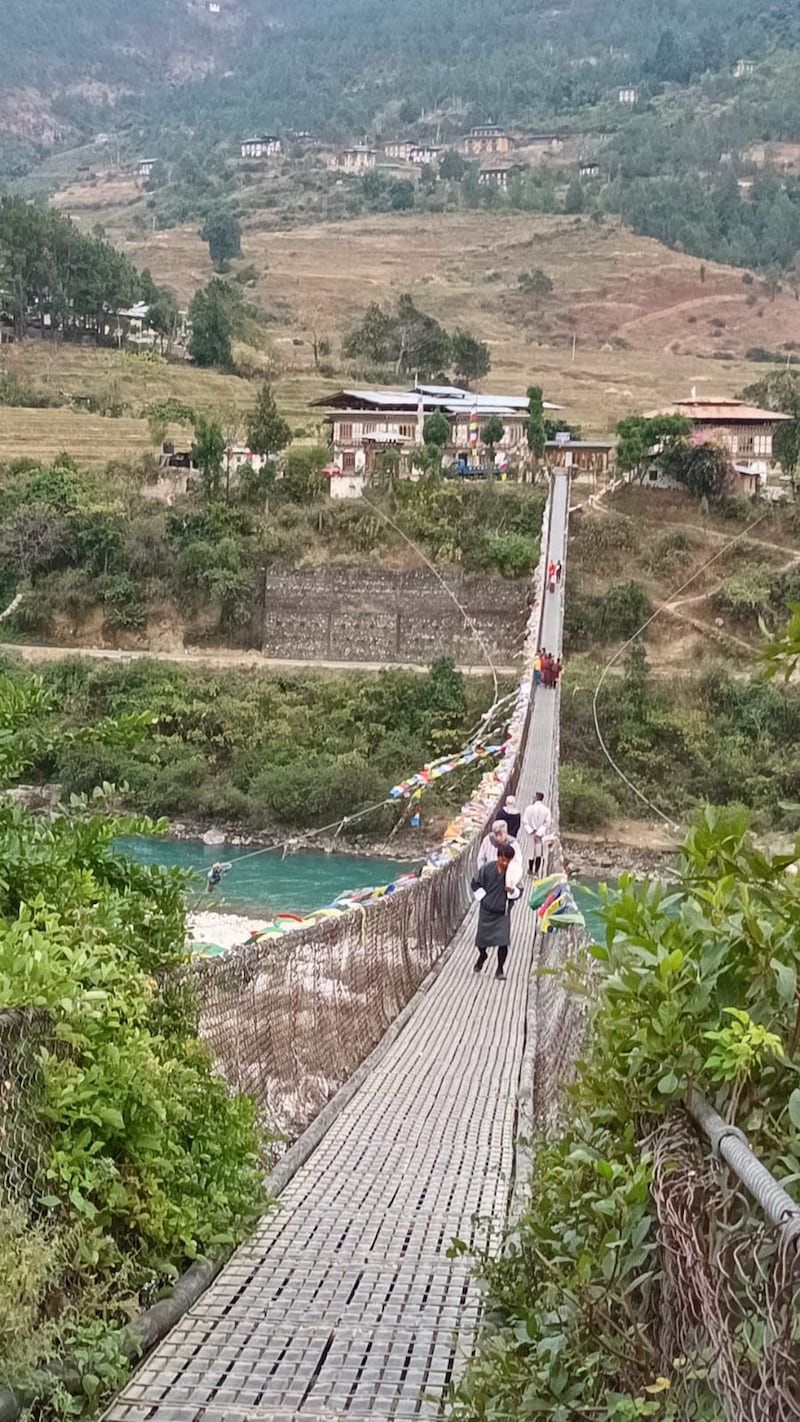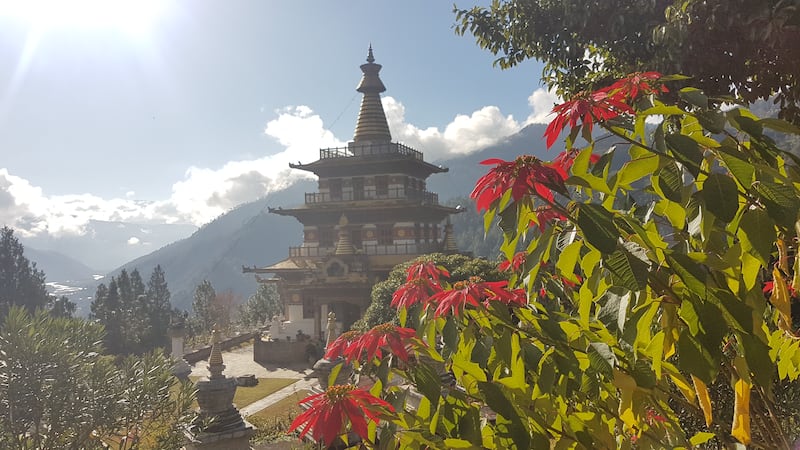Bhutan is a small country – 200 miles east-west, 100 north-south, and about 355,000 people – with much of its landmass mountainous. It has avoided political strife and, unlike neighbouring Tibet, its Buddhist culture is not under threat from China.
Bhutan has the rare distinction of being carbon neutral – it helps when over 60% of land is forest and traffic lights are unnecessary anywhere – and stewardship of its natural and cultural environment is taken very seriously.
Precious wildlife flourishes, protected by strong laws; education and healthcare are free; and most citizens are practising Buddhists. Here is a beautiful country where people seem remarkably contented and, with prayer flags a common sight, a sense of national pride and identity colours the landscape. Instead of gross national product, Bhutan does actually calculate its ‘gross national happiness’.
But there are problems to be faced. Global warming poses dangers to its Himalayan ice caps and, while the economy’s second-biggest earner comes from visitors spending money, the downsides to mass tourism are glaringly obvious: potential homes lost to Airbnb, unnecessary waste, tourist traps, pollution and other environmental damage…
Some countries have begun introducing a tourist tax, the revenue from which (we are told) will go towards mitigating some of the disadvantages that come with tourism. For the time being, such taxes are tiny but Bhutan has adopted a bolder approach: a sustainable development fee (SDF) of $100 a day for non-Indian tourists, paid up front before other costs which include a mandatory guide and driver; plus accommodation, meals and sundry other charges.

Bhutan can be an expensive holiday destination – so is a visit worth considering?
Knowing that very few pilots in the world have the training to land airplanes at the country’s only international airport makes your first live introduction to Bhutan slightly hair-raising but clearing passport control is a breeze and soon you are greeted by your guide holding out a khata (a traditional ceremonial scarf) and the adventure begins.
A typical week-long trip follows the main east-west, single carriageway highway; there is no Bhutanese term for road rage though occasional signs proclaim ‘No Hurry, No Worry’.
From Paro airport, an hour’s drive brings you to the capital city of Thimphu and its 115,000 residents perched on the lower slopes of a valley where buildings are four or five storeys at most, exterior decorations follow traditional designs and advertising hoardings are a rarity. Take the vehicles away and you could be in another era.
Here in the hills above Thimpu stands one of the largest Buddha statues in the world, over 50 metres high, its interior filled with thousands of tiny Buddha figures and a prayer hall adorned with intricate mandalas.
The journey continues eastwards through the Dochula pass (3,100m) with magnificent views of the Himalaya and then on to Punakha, a beautiful valley where the country’s most dramatic dzong – a traditional fortress now serving as an administrative and religious centre – stands overlooking the confluence of two mountain rivers.
Scarlet-clad teenage monks check their mobiles and practise playing elongated temple horns, chickens skitter around the temple’s cats and a Bhodi tree stands in the centre of the courtyard. If conversion to Buddhism is on your bucket list, it may well start in this beautiful temple where a huge figure of a benign, enlightened Buddha looks down on you.
A morning’s walk across a suspension bridge leads up through a patchwork of rice paddies and vegetable plots to Khamsum Yalley Namgyal Chorten. This pagoda-like structure is less than 20 years old, built in the traditional style as a gift to the world and filled with representations of various figures whose job is to provide protection from corrupting forces. A breakfast picnic in the grounds here has become one of my most memorable experiences.

- Travel: 7 reasons why Swedish town Lulea is a top winter breakOpens in new window
- Travel: South Korea, where the hyper-modern, K-pop, LED screen and skyscrapers meet ancient temples, tradition and stunning natural sceneryOpens in new window
- Travel: Chyulu Hills a mysterious corner of Kenya with magical appealOpens in new window
Turning off the highway, a road leads over a mountain pass to the expansive Phobjikha valley where hiking trails abound and, in winter, flocks of the globally endangered black necked crane, flying in across the Himalaya from Tibet, roost in the marshes of the valley floor, welcomed by the valley’s potato farmers who hold a festival to herald their arrival.
After the drive back to Paro, a town surrounded by rice paddies, any trip has to conclude with a hike up to Taktsang Monastery, 3,000 metres above the Paro valley, known as the Tiger’s Nest.
The climb, winding around the edge of a mountainside forested by blue pines, brings its reward on reaching a series of small temples clinging to mountain ledges. The final leg of the climb begins with a stepped descent, followed by a stamina-demanding climb on the other side.
For Bhutanese, the trek is a serious pilgrimage for paying Buddhist respect; for tourists, karma comes from reaching the top of what from the ground looks an impossible place to reach.

The National Museum is in Paro, established inside a curious, centuries-old circular fort, and has displays relating to the four branches of Buddhism, wise sayings of the Buddha, ancient artefacts and, apparently, a stone egg laid by a donkey.
Paro has lots of craft shops containing desirable though pricy items but the best thing to take home from Bhutan is the knowledge that a place exists where nature and people are still, as yet, unscarred by modernity’s ill effects and where, if a hefty tourist tax is the price to help keep it that way, then perhaps it is worth paying.
Getting There
Only two airlines fly into Bhutan, Drukair and Bhutan Airlines mostly from Delhi. Many airlines fly to Delhi and I travelled with Air Astana with return economy fares between Heathrow and Delhi from £545 and the option of an inexpensive stopover in Almaty. Visa and SDF payments for Bhutan can be made online or through a tour agency. I travelled with a tour company, Bhutan Lost Kingdom Tours, that is well able to arrange an itinerary to suit different budgets and interests.
There are superb luxury hotels in Bhutan belonging to Six Senses, &Beyond and COMO, as well as the independent Gangtey Lodge, but they add considerably to the cost of a trip.
For further information, see Bhutan’s Department of Tourism and – a useful place to begin your research and look at wonderful hiking options – the new Lonely Planet guide to Bhutan. If identifying some of Bhutan’s 600 species of birds appeals, binoculars and Birds of Bhutan and the Eastern Himalayas earn a place in your luggage.








